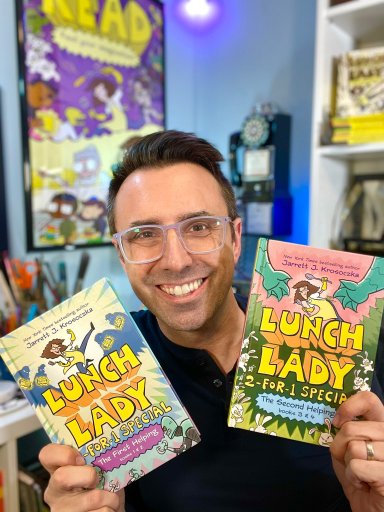The first four books in the popular graphic novel series Lunch Lady by award-winning author Jarrett J. Krosoczka were just reissued for the first time as hardcover, full-color two-books-in-one editions: The First Helping (Lunch Lady 1 and 2) and The Second Helping (Lunch Lady 3 and 4). The graphic novels are a bright and hilarious series about a crime-fighting lunch lady.
Cartoonist Jarrett J. Krosoczka has been working in comics for decades and has written a fabulous personal essay about his experience in the comics world of the ’00s which we have the honor of presenting.
See out what Krosoczka has to say about the decade of comics that kicked off a new century!
It’s sort of like The Muppet Movie. An array of misfits from across the country somehow find one another and form familial bonds. But instead of creatures made of felt, fur, and googly eyes, I’m talking about graphic novelists. And I’m talking specifically the graphic novelists who made their debuts in the aughts, a time when the trade children’s publishers were only beginning to dip their toes into the world of comics.
Let me begin with a bit of backstory on my entry into this world. I made my debut as a picture book author/illustrator in 2001. And while on that first-ever book tour, I ran into Jeanne, the beloved lunch lady of my youth. I was visiting my grammar school alma mater and was taken to see that she was still dutifully feeding the kids. That’s was the original seed for a story that grew to become my Lunch Lady graphic novels. But publication for those books would still be some years away. As I toiled away on building that world, I published picture book after picture book. I learned everything I could about how traditionally published trade books got sent out to the world.
While traveling to support my books, including countless educational conferences, I befriended many authors and illustrators. Most notably, I became friends with siblings Jennifer Holm and Matthew Holm. Jenni, an award-winning middle-grade novelist, was cooking up the kind of comic that she never had as a kid. A plucky, precocious female heroine that lived an ordinary life on the outside but fantastical one in her mind. Jenni tapped her brother to illustrate what would become the iconic Babymouse. At the time, Lunch Lady and Babymouse only lived in sketchbooks and book pitches. The Holm siblings made their comics debut with Babymouse: Queen of the World in 2006. Random House Children’s Books, unsure if the format would work in traditional channels, published Babymouse in a limited color palette. Knopf Books for Young Readers, a division of Random House Children’s Books, followed suit with that strategy when it released Lunch Lady and the Cyborg Substitute in 2009.
In that era, we graphic novelists with a background in trade publishing, attended Comic Cons. Conversely, graphic novelists with a background in comics publishing, attended conferences for educators and librarians.
At a small state librarians’ conference, I tabled next to Raina Telgemeier. While it was our first meeting IRL, we had been friends on MySpace for some years. (I still regret not buying some of the original art pages she had in a binder for about $50 a pop.) I ran into Gene Luen Yang at San Diego ComicCon as he signed copies of American Born Chinese. The group grew in numbers—Ben Hatke, Faith Erin Hicks, Jerry Craft, Raul the Third, LeUyen Pham…the list goes on. We all traded notes. The comics people knew how to table, the trade people knew how to setup successful school visits.
We were all kids who grew up with Saturday Morning Cartoons, Snoopy in the newspaper, monthly superhero comics, and school book fairs filled with the works of Beverly Cleary and Judy Blume. When we were young, we doodled and dreamed. And as we were writing in our LiveJournals and chatting over AOL Instant Messenger, Scholastic published Jeff Smith’s Bone in full color, First Second put out Gene’s American Born Chinese, and Random House Children’s Books got Jenni and Matt’s Babymouse in every single school library. This convergence allowed for all of us to have a go at living out our childhood fantasies of living amongst word balloons and comics panels with our own original characters.
I remember that time with fond nostalgia as I hum the song Kermit and Fozzie Bear sang on this cross-country road trip… “Movin’ right along in search of good times and good news,
With good friends, you can’t lose…”
Source: Graphic Policy


